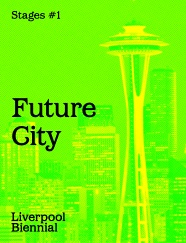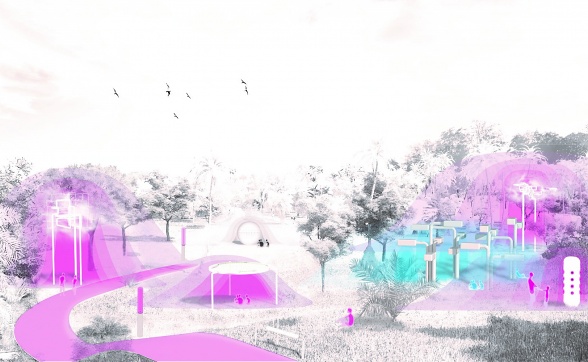
Towards A Thermodynamic Urban Design
Philippe Rahm

Over the last forty years, the history of urban and regional planning has been written from a macroscopic and aesthetic point of view, as opposed to a microscopic and physiological one. By re-analysing this urban story through a microscopic prism, we can discover other factors that have been more relevant in the construction of cities and the composition of their forms. A reassessment will allow us to offer an alternative to the present urban development, which is currently based on the phenomenon of an unbalanced and unethical economic globalisation. Our ambition is to look to a more sustainable, humanistic and equitable global urbanisation for all.
If we think of urban planning in terms of Thermodynamics, we could start to imagine a new strategy of globalisation: a global redeployment of industrial production in a world based on energy and climate criteria, rather than on the current financial or economic criteria. For example, in the current crisis of the European model of the ‘Post-industrial society’, France has recently decided to re-industrialise itself. This seems necessary in order to achieve a world balance in the coming years between the South and the North. If the North is to experience a re-industralisation, the South will have to increase the social and health conditions of workers. So, if we are looking for a new equilibrium to achieve this new stage in globalisation, we must know which criteria will become important when planning on a global scale.
The current division between design conception and industrial production is primarily caused by the out-sourcing of industrial production to countries where labour is cheaper and the labour law is the least restrictive. The result is a continual shifting of the place of production as industries search for the most economical solution. Consequently, social and ecological inequalities that can no longer be accepted arise. We need to find a future with an overall balance between the cost and the social conditions of work.
 Jade Eco Park, 2012-2015, Taichung, Taiwan, Philippe Rahm architectes, Mosbach paysagistes, Ricky Liu & Associates
Jade Eco Park, 2012-2015, Taichung, Taiwan, Philippe Rahm architectes, Mosbach paysagistes, Ricky Liu & Associates
To begin to define the concept of Urban Thermodynamics, we can draw on three examples that have, in a new and innovative way, managed to exploit energy resources related to their unique geographical position.
The first
example is the relocation of Facebook servers from California to the Arctic
Circle in Lulea, Sweden. Computers that hold huge amounts of data overheat and
require a great deal of energy to be cooled. Therefore, it is easy to
understand the decision to relocate the servers from the Californian climate,
where the annual temperature is 19.5 degree Celsius, to the cooler climate of
Lulea, where the average annual temperature of is 2 degrees Celsius. This shift
in location and climate results in huge energy savings, which in turn saves
several tens of billions of US dollars for the American-owned company.
Jade Eco Park, 2012-2015, Taichung, Taiwan, Philippe Rahm architectes, Mosbach paysagistes, Ricky Liu & Associates
The second example is in the small village of Trient in Switzerland. The village is located in the remote mountains of Valais and has a small population of 150 inhabitants. In the coming years, the village will receive several million Swiss Francs in hydraulic royalties. This is thanks to the town’s unique glacial dam, which supplies electricity to the Swiss railway network.
The third example is the German Desertec Project. The project proposes to cover a small part of the Sahara Desert with solar panels, with the aim to supply all the electricity needs of North Africa and Europe.
These three examples reveal surprising geographical locations for a new urban development, focusing on locations that were previously not populated and never urbanised, such as the far north, the desert and the mountains. Thus, the twenty-first century is going to see a radical change in the criteria of geographical value; we will perhaps witness a relocation of human geography, which will cause the creation of new cities and the decline of old. Climate can play a primary role in the future urbanisation of the planet. Following global thermodynamic values related to parameters of geographical location, latitude and altitude can be proposed as a solution for a globalisation that will no longer be based on wages or working injustices, but on ecological and climatic factors, towards sustainable development for humanity. We could call this new type of urbanisation ‘Thermodynamic Urban Planning’, based on a world redistribution of the urbanisation on the planet according to the locations of the renewable energy resources today.
Download this article as PDF
Philippe Rahm
Philippe Rahm is an Architect and Principal in the office of Philippe Rahm Architectes, Paris. His work, which extends the field of architecture from the physiological to the meteorological, has received an international audience in the context of sustainability. He has been nominated for several international architectural awards, and has participated in a number of exhibitions worldwide, including at Archilab, Guggenheim, New York and Manifesta.
- Future City
Vanessa Boni, Deena Chalabi, Michelle Dezember - Three Scenes and Speculations from a Future City
Rami El Samahy and Adam Himes - Walking Towards Revolution
Omar Kholeif - Interview with Slavs and Tatars
Deena Chalabi - Futurist Library
Bahbak Hashemi-Nezhad and Lola Halifa-Legrand - Dispatches on the Future City
Hamid Dabashi - Building a Public Realm: Imagining a Future for Old Doha
Michelle Dezember - What is our Globalised Urban Future?
Saskia Sassen and Irit Rogoff - How do Resources Impact our Ability to Think About the Future?
Noura Al Sayeh - Towards A Thermodynamic Urban Design
Philippe Rahm - What Do We Need to Deconstruct?
Nasser Rabbat - We Are Here to Stay
Jeanne van Heeswijk and Britt Jurgensen - Colophon